Numerical Investigation of Burst Capacity in Pressure Armour Layer of Flexible Risers
Abstract
1. Introduction
2. Analytical Model
3. Numerical Model
3.1. The Basics
3.2. Axisymmetric Model
3.3. Full 3D Model
3.4. PBC Model
- (1)
- Between the PE and PA layers, a rough tangential formulation was applied with hard normal contact and separation allowed after contact. This choice ensures that the PE acts purely as a load transmitter without allowing unrealistic sliding at the interface, while still permitting detachment under high internal pressure [39].
- (2)
- Between the PA strips, a penalty tangential formulation was used with a friction coefficient of 0.1, while normal behaviour was defined as hard contact with separation allowed after contact. The penalty formulation with a calibrated friction coefficient reflects experimental observations of limited slip between PA strips and prevents artificial locking, consistent with the experimental results [34].
- (3)
- Between the PA and the outer sheath, a rough tangential formulation was employed with hard normal contact, but separation after contact was not permitted. This constraint was necessary to mimic the physical role of the outer sheath in resisting radial expansion and providing continuous confinement to the PA layer during pressurisation.
3.5. Results
4. Discussion
5. Conclusions
- The axisymmetric 2D model, although extremely fast, significantly underestimated the collapse pressure because it cannot represent the inherently three-dimensional mechanics of the helical strip. The absence of lay-angle-induced bending–torsion coupling, discrete Z-lock contact, and shear transfer between neighbouring strips leads to an underprediction of global stiffness.
- The full 3D helical model captured all geometric and contact-related effects explicitly, including localised locking deformation and helix-induced stiffening. As a result, it predicted a slightly higher collapse pressure than the analytical reference and provided the most realistic stress field. However, its computational cost was prohibitively high for use in design optimisation or parametric studies.
- The PBC model closely reproduced the analytical hoop stress response while maintaining a slightly conservative prediction relative to the full 3D model. By eliminating end effects and enforcing periodicity, it retained the essential mechanics of the interlocking Z-shaped strip while achieving a reduction in runtime of more than an order of magnitude.
Author Contributions
Funding
Data Availability Statement
Conflicts of Interest
References
- Saneian, M.; Han, P.; Jin, S.; Bai, Y. Fracture response of steel pipelines under combined tension and torsion. Thin-Walled Struct. 2020, 154, 106870. [Google Scholar] [CrossRef]
- Saneian, M.; Han, P.; Jin, S.; Bai, Y. Fracture response of steel pipelines under combined tension and bending. Thin-Walled Struct. 2020, 155, 106987. [Google Scholar] [CrossRef]
- Zhang, Y.; Liu, W.; Kuang, W.; Saneian, M.; Bai, Y. Mechanical behaviour analysis of steel strips reinforced thermoplastic pipe under torsion. Ocean. Eng. 2024, 303, 117655. [Google Scholar] [CrossRef]
- Zhang, Y.; Liu, W.; Saneian, M.; Bai, Y. A comprehensive study on the failure modes of steel strips reinforced thermoplastic pipe under torsion. Int. J. Press. Vessel. Pip. 2025, 216, 105490. [Google Scholar] [CrossRef]
- Bai, Y.; Zhang, Y.; Saneian, M.; Fang, P.; Quintero, J.; Ye, Q. Structural integrity of pipe-joint entirety under multi-axial loading: Comparative assessment of butt-joints and mid-joints. Ocean. Eng. 2025, 342, 122911. [Google Scholar] [CrossRef]
- de Sousa, J.R.M.; Sagrilo, L.V.S.; Rocha, D.M. Semi-empirical equations to predict the bisymmetric dry and wet hydrostatic collapse strengths of flexible pipes. Appl. Ocean. Res. 2022, 122, 103129. [Google Scholar] [CrossRef]
- Saneian, M.; Bai, Y. Assessment of the Carcass Role in Designing Deepwater Riser Connectors. In Proceedings of the International Conference on Offshore Mechanics and Arctic Engineering, Glasgow, UK, 9–14 June 2019; Volume 58806, p. V05AT04A033. [Google Scholar] [CrossRef]
- Saneian, M.; Bai, Y. Evaluation of the Inner Liner in Unbounded Flexible Pipelines in the Sealing System of End-Fitting. In Proceedings of the International Conference on Offshore Mechanics and Arctic Engineering, Singapore, 9–14 June 2024; Volume 87806, p. V003T04A004. [Google Scholar] [CrossRef]
- Zhang, Y.; Saneian, M.; Bai, Y.; Fang, P.; Cheng, P.; Zhao, L. Test-based equivalent-material method for collapse qualification of helically wound and layered cylindrical structures-with application to flexible-riser carcass. Nat. Commun. Eng. 2025. [Google Scholar] [CrossRef]
- Bai, Y. Deepwater Flexible Risers and Pipelines; John Wiley & Sons: Hoboken, NJ, USA, 2020. [Google Scholar]
- Det Norske Veritas. Project Recommended Practice: Composite Risers; Technical Report; Report No. 2002-0067; Det Norske Veritas: Høvik, Norway, 2002. [Google Scholar]
- Féret, J.J.; Bournazel, C.L. Calculation of Stresses and Slip in Structural Layers of Unbonded Flexible Pipes. J. Offshore Mech. Arct. Eng. 1987, 109, 263–269. [Google Scholar] [CrossRef]
- De Oliveira, J.; Goto, Y.; Okamoto, T. Theoretical and methodological approaches to flexible pipe design and application. In Proceedings of the Annual Offshore Technology Conference, Houston, TX, USA, 6–9 May 1985; pp. 517–526. [Google Scholar] [CrossRef]
- Colquhoun, R.; Hill, R.; Nielsen, R. Design and materials considerations for high pressure flexible flowlines. In Proceedings of the SUT Advances in Subsea Pipeline Engineering and Technology, Aberdeen, UK, 30–31 May 1990; pp. 145–178. [Google Scholar]
- Fernando, U.S.; Tan, Z.; Sheldrake, T.; Clements, R. The stress analysis and residual stress evaluation of pressure armour layers in flexible pipes using 3D finite element models. In Proceedings of the International Conference on Offshore Mechanics and Arctic Engineering, Vancouver, BC, Canada, 20–25 June 2004; Volume 37459, pp. 57–65. [Google Scholar] [CrossRef]
- Zhu, X.K.; Leis, B.N. Theoretical and Numerical Predictions of Burst Pressure of Pipelines. J. Press. Vessel. Technol. 2007, 129, 644–652. [Google Scholar] [CrossRef]
- Gay Neto, A.; Martins, C.v.d.A.; Pesce, C.P.; Meirelles, C.O.C.; Malta, E.R.; Barbosa Neto, T.F.F.; Godinho, C.A.F. Burst prediction of flexible pipes. In Proceedings of the International Conference on Offshore Mechanics and Arctic Engineering, Shanghai, China, 6–11 June 2010; Volume 49132, pp. 511–520. [Google Scholar] [CrossRef]
- Neto, A.G.; Martins, C.D.A.; Pesce, C.P.; Meirelles, O.C.; Malta, E.R. Prediction of burst in flexible pipes. J. Offshore Mech. Arct. Eng. 2013, 135, 011401. [Google Scholar] [CrossRef]
- Cuamatzi-Melendez, R.; Castillo-Hernández, O.; Vázquez-Hernández, A.; Albiter, A.; Vaz, M. Finite element modeling of burst failure in unbonded flexible risers. Eng. Struct. 2015, 87, 58–69. [Google Scholar] [CrossRef]
- O’halloran, S.; Connaire, A.; Harte, A.M.; Leen, S.B. Modelling of fretting in the pressure armour layer of flexible marine risers. Tribol. Int. 2016, 100, 306–316. [Google Scholar] [CrossRef]
- Liu, X.; Qu, Z.; Liu, Y.; He, J.; Si, G.; Wang, S.; Liu, Q. Numerical Simulation of Burst Failure in 2.5-Inch Unbonded Flexible Riser Pressure Armor Layers. Metals 2024, 14, 762. [Google Scholar] [CrossRef]
- Wei, R.; Li, X.; Vaz, M.A.; Custódio, A.B. Finite Element Modelling of Pressure Armour Unlocking Failure in Unbonded Flexible Risers. J. Mar. Sci. Eng. 2025, 13, 411. [Google Scholar] [CrossRef]
- Santos, C.C.; Pesce, C.P. An alternative strategy for offshore flexible pipes finite element analysis. Mar. Struct. 2019, 65, 376–416. [Google Scholar] [CrossRef]
- Timoshenko, S.P.; Goodier, J.N. Theory of Elasticity, 2nd ed.; McGraw–Hill: New York, NY, USA, 1951. [Google Scholar]
- Lamé, G. Leçons sur la Théorie Mathématique de L’élasticité des Corps Solides; Bachelier: Paris, France, 1852. [Google Scholar]
- Martins, C.v.A.; Pesce, C.P.; Aranha, J.A. Structural behavior of flexible pipe carcass during launching. In Proceedings of the International Conference on Offshore Mechanics and Arctic Engineering, Cancun, Mexico, 8–13 June 2003; Volume 36827, pp. 537–546. [Google Scholar] [CrossRef]
- American Petroleum Institute. API Specification 17J: Specification for Unbonded Flexible Pipe; American Petroleum Institute: Washington, DC, USA, 2014. [Google Scholar]
- Krishna, S.; Manna, I.; Glushych, V.; Weisheit, A.; Dutta Majumdar, J. Microstructural Evolution and Wear Resistance of Surface Alloyed AISI 316L Stainless Steel with Equi-atomic CoCrFeMnTi by Continuous Wave Diode Laser. Opt. Laser Technol. 2024, 179, 111345. [Google Scholar] [CrossRef]
- Yan, F.; Liu, G.; Tao, N.; Lu, K. Strength and ductility of 316L austenitic stainless steel strengthened by nano-scale twin bundles. Acta Mater. 2012, 60, 1059–1071. [Google Scholar] [CrossRef]
- Cornacchia, F.; Liu, T.; Bai, Y.; Fantuzzi, N. Tensile strength of the unbonded flexible pipes. Compos. Struct. 2019, 218, 142–151. [Google Scholar] [CrossRef]
- API. RP17B: Recommended Practice for Flexible Pipe; American Petroleum Institute: Washington, DC, USA, 2008. [Google Scholar]
- Dassault Systèmes. ABAQUS/Standard User’s Manual; SIMULIA: Johnston, RI, USA, 2024. [Google Scholar]
- Belytschko, T.; Bindeman, L.P. Assumed strain stabilization of the eight node hexahedral element. Comput. Methods Appl. Mech. Eng. 1993, 105, 225–260. [Google Scholar] [CrossRef]
- Saevik, S.; Berge, S. Fatigue testing and theoretical studies of two 4 in flexible pipes. Eng. Struct. 1995, 17, 276–292. [Google Scholar] [CrossRef]
- Dong, L.; Huang, Y.; Zhang, Q.; Liu, G. An analytical model to predict the bending behavior of unbonded flexible pipes. J. Ship Res. 2013, 57, 171–177. [Google Scholar] [CrossRef]
- Smith, D.M.; Cunningham, L.S.; Chen, L. Efficient finite element modelling of helical strand cables utilising periodicity. Int. J. Mech. Sci. 2024, 263, 108792. [Google Scholar] [CrossRef]
- Fang, P. Development of an Effective Modelling Method for the Local Mechanical Analysis of Submarine Power Cables. Ph.D. Thesis, Delft University of Technology, Delft, The Netherlands, 2024. [Google Scholar]
- Li, S.; Sitnikova, E. An excursion into representative volume elements and unit cells. Compr. Compos. Mater. II 2017, 1, 451–489. [Google Scholar] [CrossRef]
- Zhang, M.; Chen, X.; Fu, S.; Guo, Y.; Ma, L. Theoretical and numerical analysis of bending behavior of unbonded flexible risers. Mar. Struct. 2015, 44, 311–325. [Google Scholar] [CrossRef]
- Bai, Y.; Bai, Q. Subsea Pipelines and Risers, 2nd ed.; Elsevier Science: Oxford, UK, 2005. [Google Scholar]
- Provasi, R.; Toni, F.G.; de Arruda Martins, C. Friction coefficient influence in a flexible pipe: A macroelement model. Ocean. Eng. 2022, 266, 112719. [Google Scholar] [CrossRef]


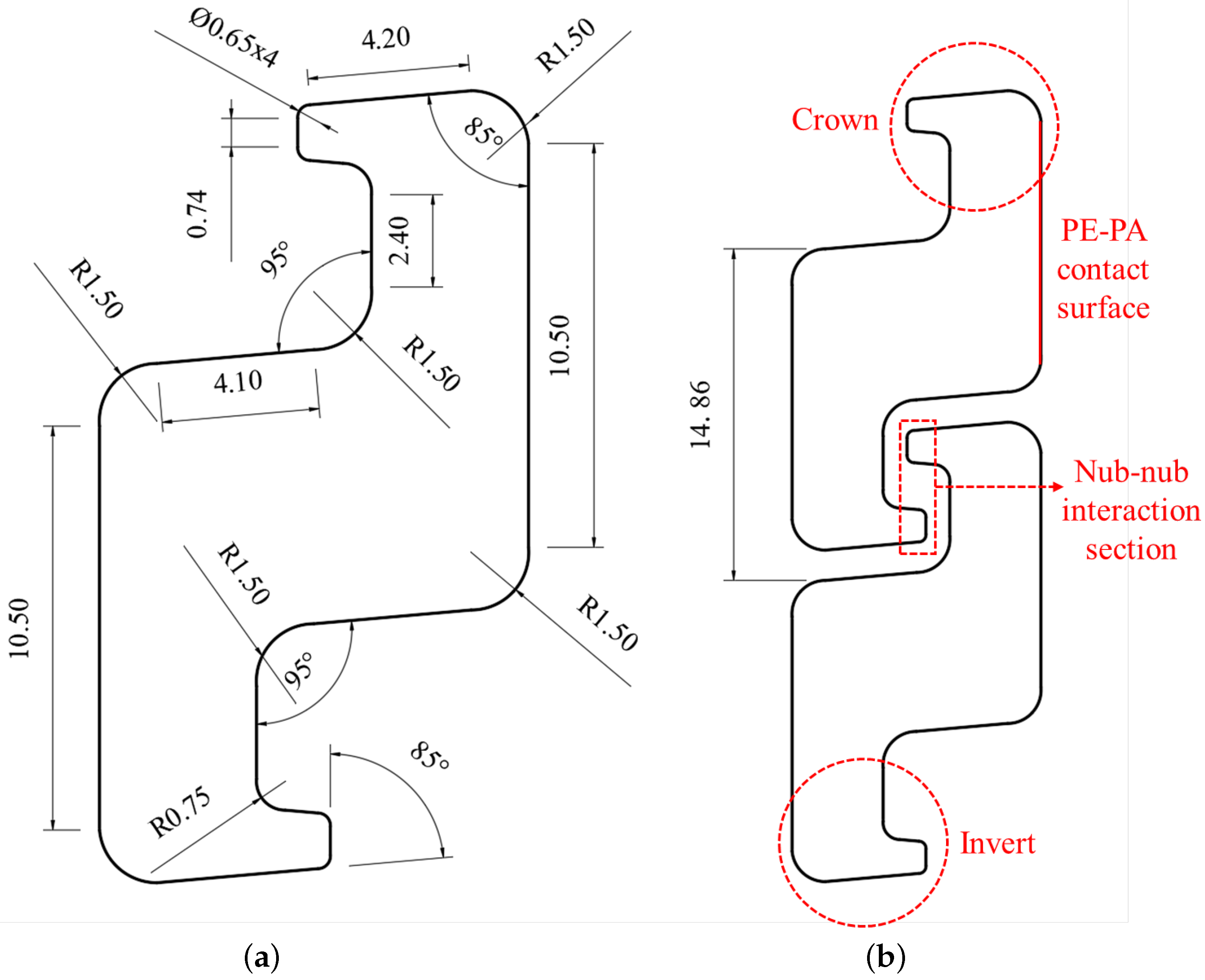

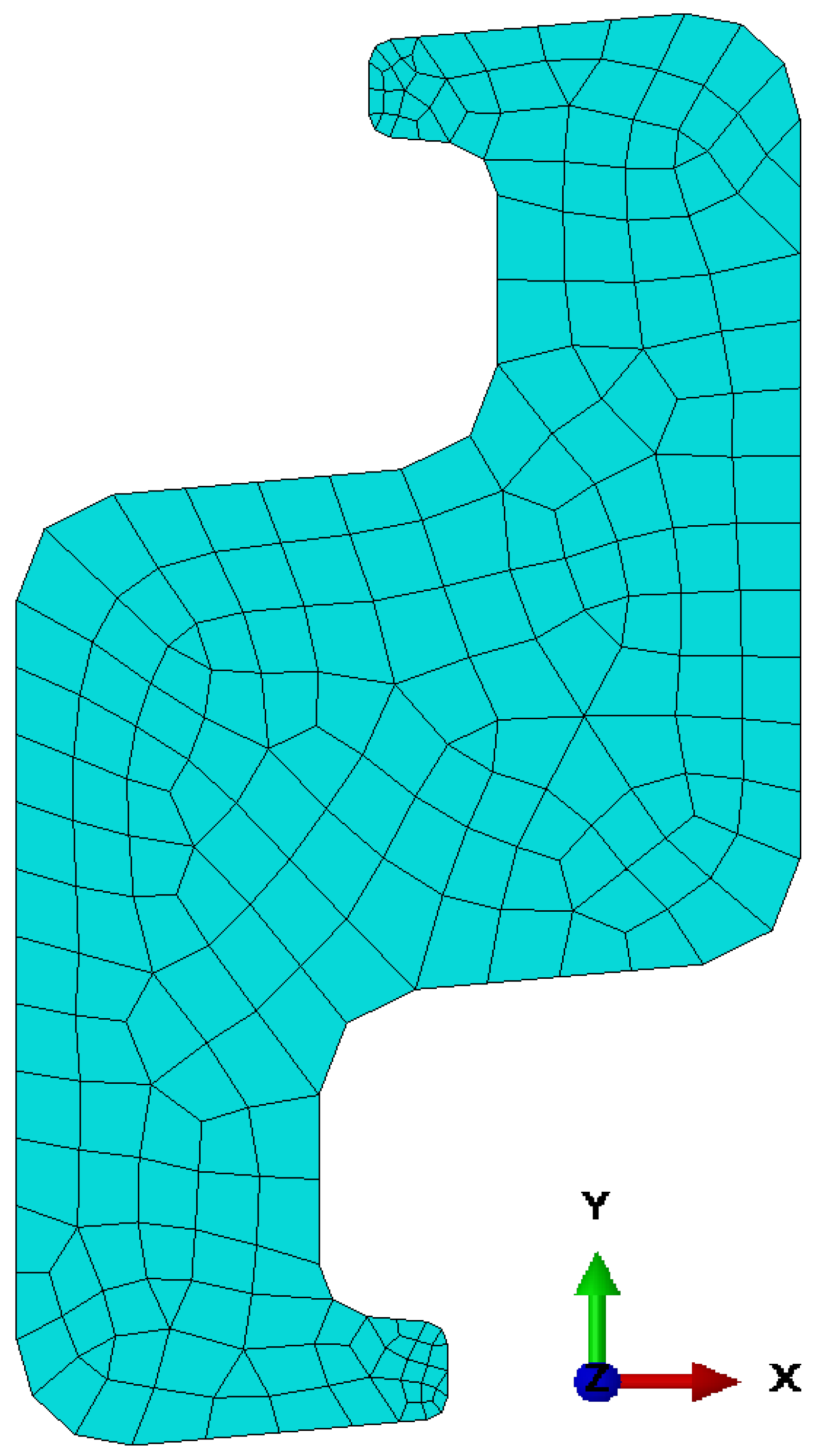
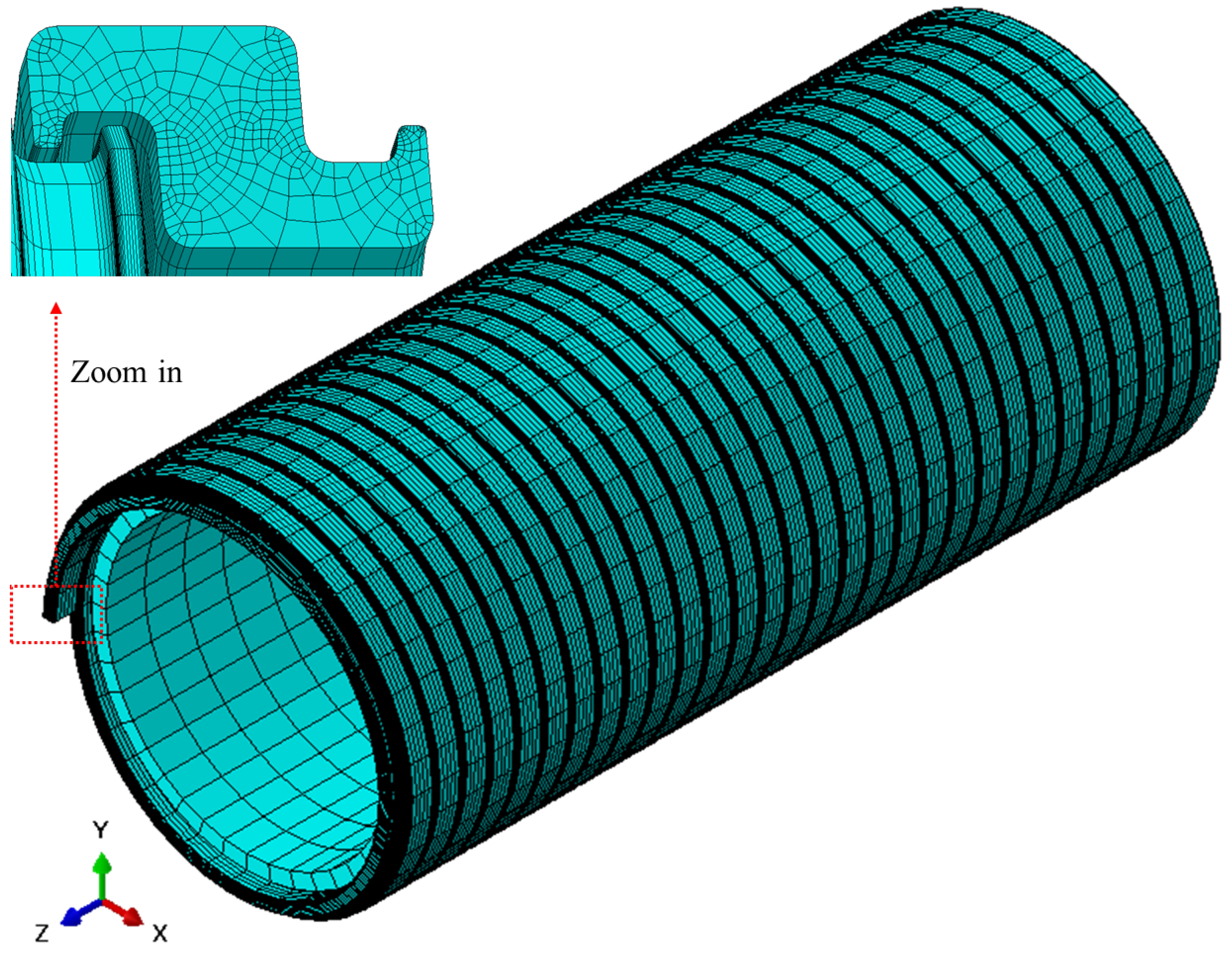


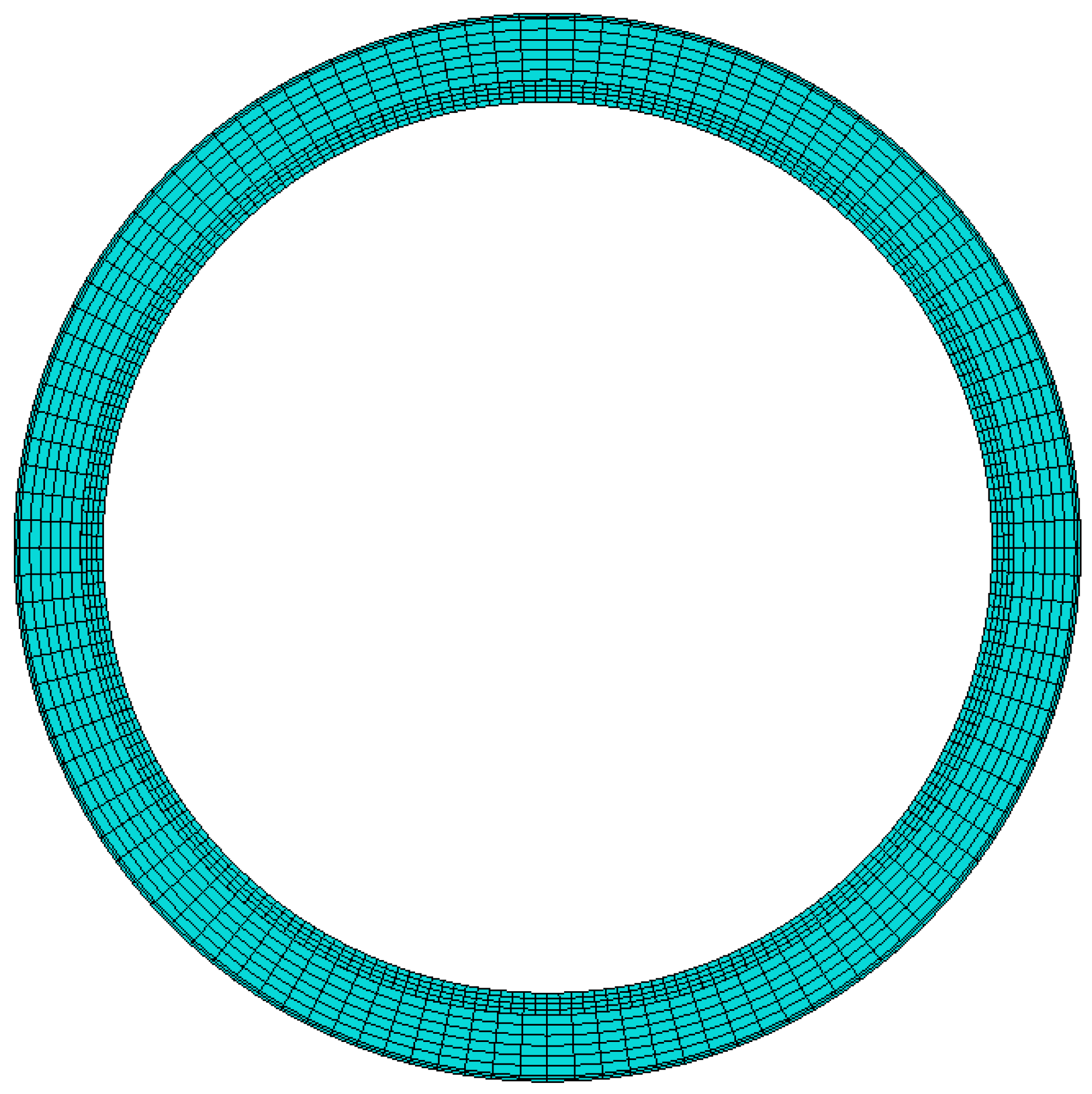

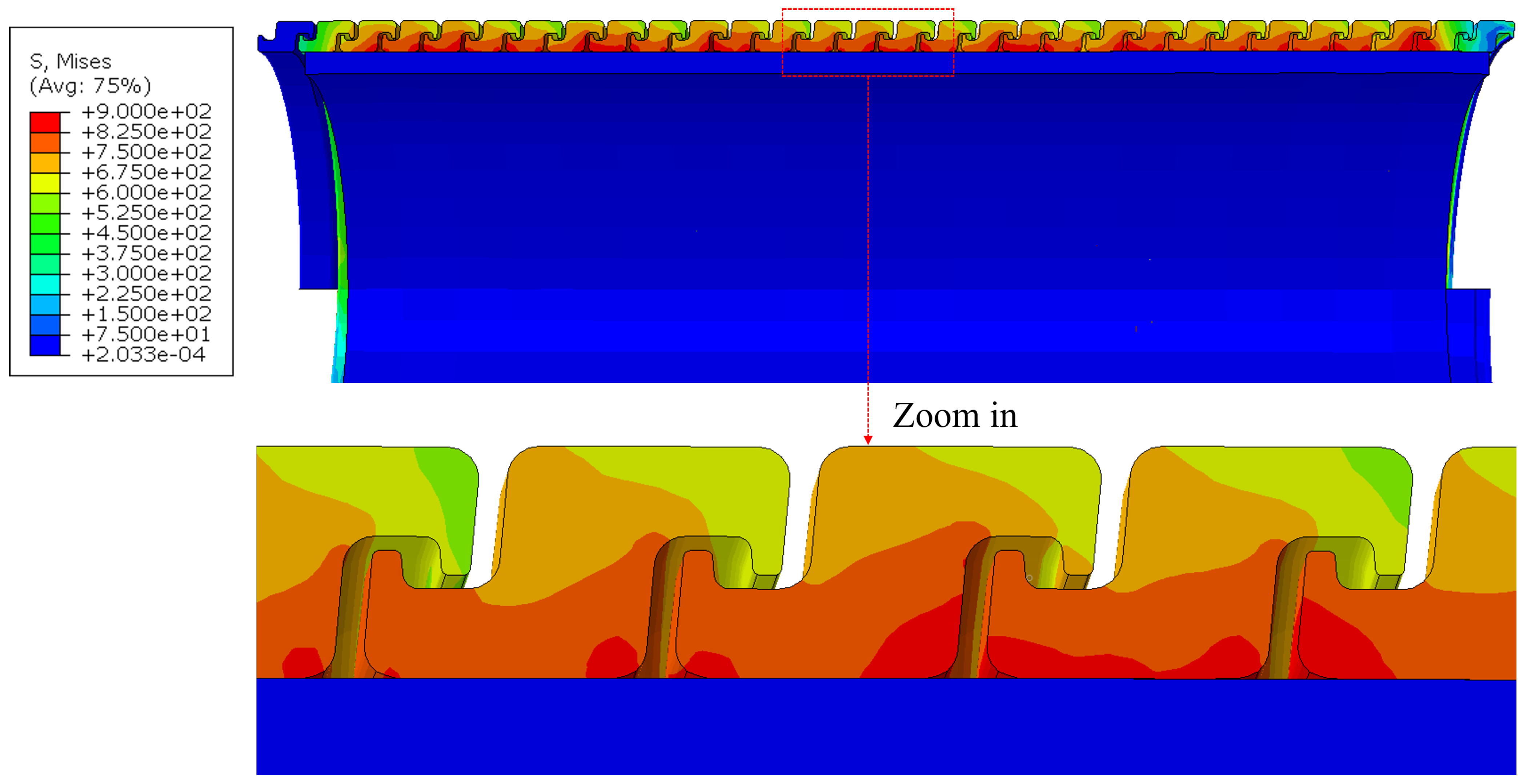

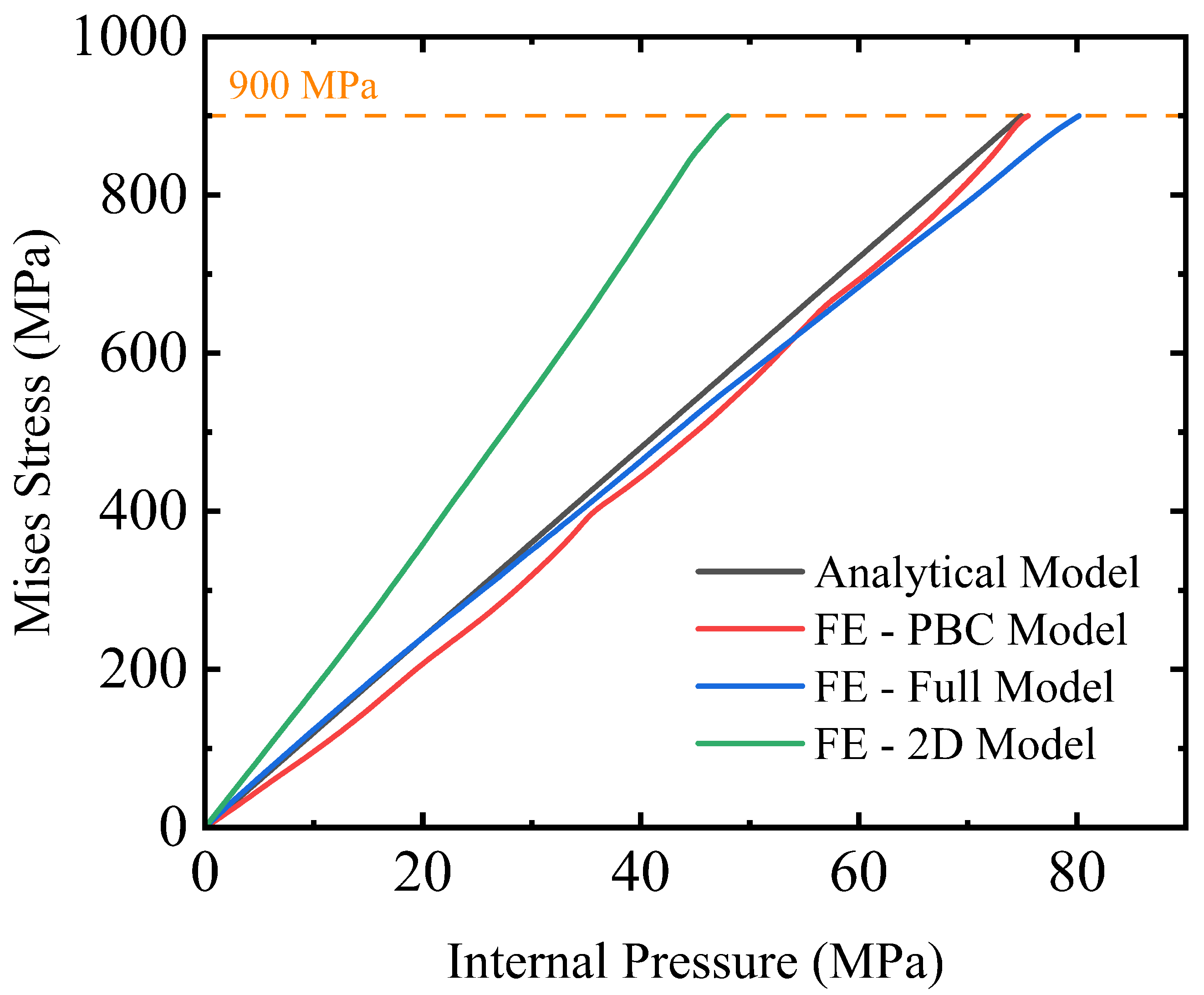
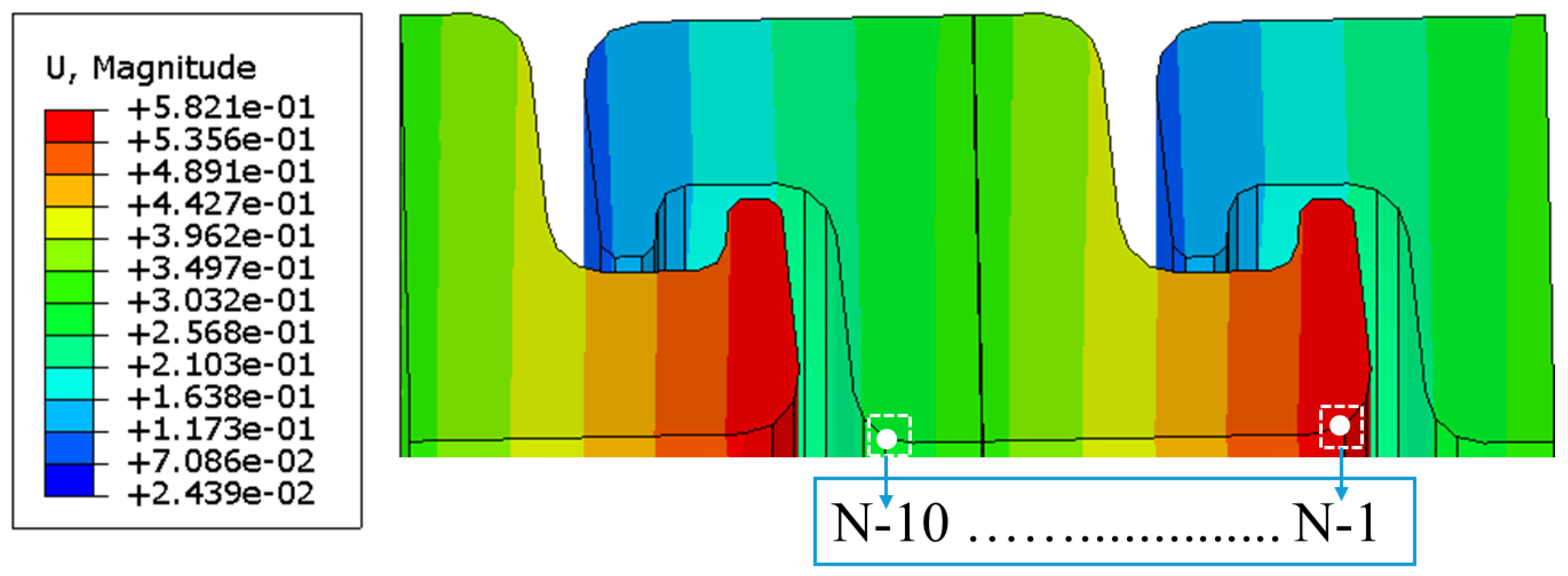
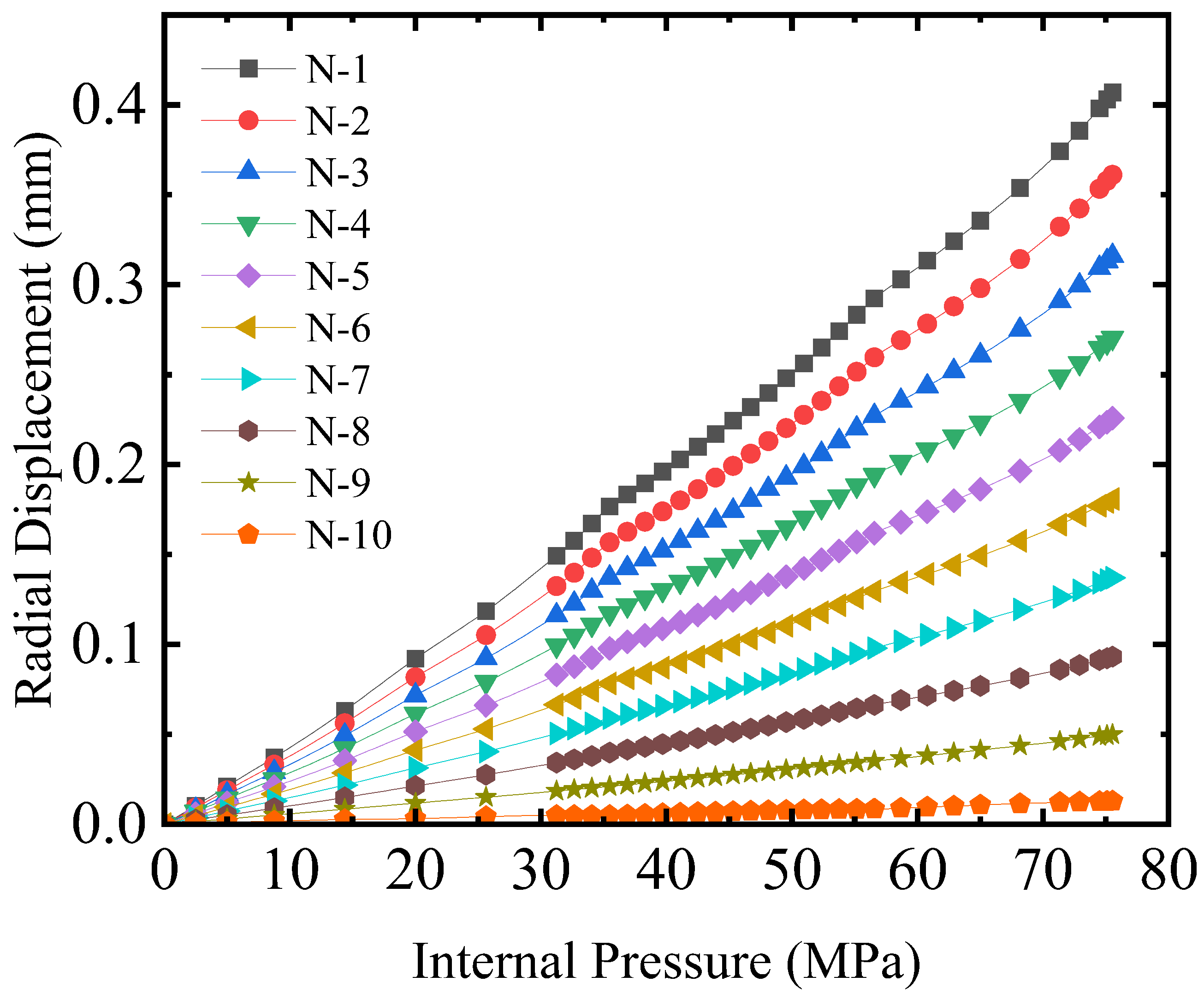
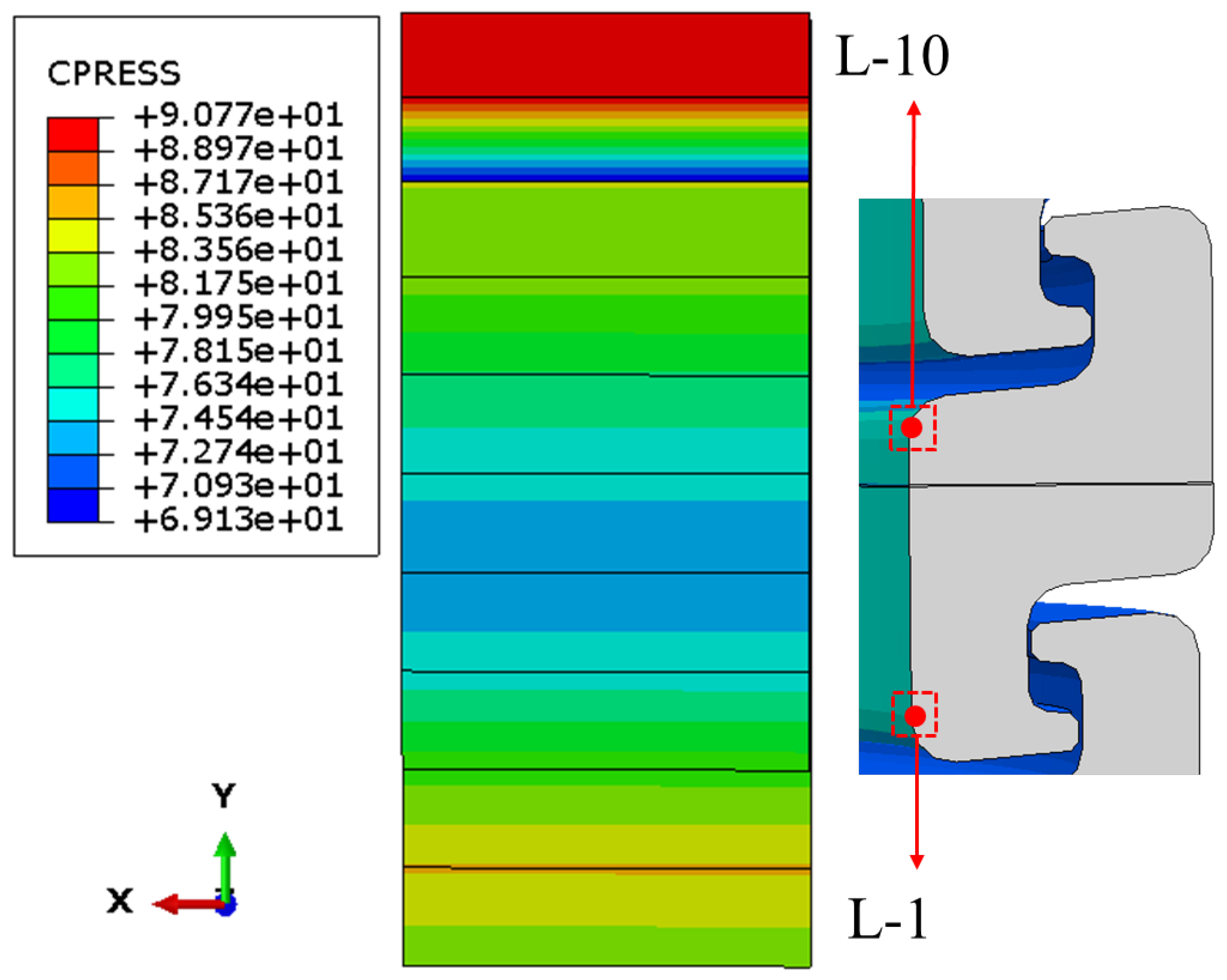

| Parameter | Pressure Armour | HDPE |
|---|---|---|
| Poisson’s ratio (1) | 0.29 | 0.45 |
| Young’s Modulus (MPa) | 208,160 | 1134 |
| Yield strength (MPa) | 900 | - |
| Models | Analytical | FE-2D | FE-Full | FE-PBC |
|---|---|---|---|---|
| Critical IP (MPa) | 74.90 | 48.00 | 80.19 | 75.55 |
| Computational cost (s) | / | 40 | 16,408 | 1075 |
Disclaimer/Publisher’s Note: The statements, opinions and data contained in all publications are solely those of the individual author(s) and contributor(s) and not of MDPI and/or the editor(s). MDPI and/or the editor(s) disclaim responsibility for any injury to people or property resulting from any ideas, methods, instructions or products referred to in the content. |
© 2025 by the authors. Licensee MDPI, Basel, Switzerland. This article is an open access article distributed under the terms and conditions of the Creative Commons Attribution (CC BY) license (https://creativecommons.org/licenses/by/4.0/).
Share and Cite
Saneian, M.; Zhang, Y.; Fang, P.; Bai, Y. Numerical Investigation of Burst Capacity in Pressure Armour Layer of Flexible Risers. J. Mar. Sci. Eng. 2025, 13, 2182. https://doi.org/10.3390/jmse13112182
Saneian M, Zhang Y, Fang P, Bai Y. Numerical Investigation of Burst Capacity in Pressure Armour Layer of Flexible Risers. Journal of Marine Science and Engineering. 2025; 13(11):2182. https://doi.org/10.3390/jmse13112182
Chicago/Turabian StyleSaneian, Mohsen, Yuteng Zhang, Pan Fang, and Yong Bai. 2025. "Numerical Investigation of Burst Capacity in Pressure Armour Layer of Flexible Risers" Journal of Marine Science and Engineering 13, no. 11: 2182. https://doi.org/10.3390/jmse13112182
APA StyleSaneian, M., Zhang, Y., Fang, P., & Bai, Y. (2025). Numerical Investigation of Burst Capacity in Pressure Armour Layer of Flexible Risers. Journal of Marine Science and Engineering, 13(11), 2182. https://doi.org/10.3390/jmse13112182







